Literature Review: Evolution of Leadership Theories and Applicability
VerifiedAdded on 2022/12/30
|9
|2746
|47
Literature Review
AI Summary
This literature review delves into the evolution of leadership theories, starting with the Great Man theory and progressing through trait, behavioral, and contingency theories, culminating in transformational leadership. It examines the key concepts, strengths, and weaknesses of each theory, highlighting their impact on leadership styles and practices. The review emphasizes the applicability of these theories in the contemporary business environment, particularly focusing on the relevance of transformational and contingency leadership approaches. It also discusses the importance of leadership in various spheres, from professional to personal, underscoring its significance in the 21st century and the need for leaders to adapt their styles to suit different situations and foster strong relationships with their teams. The assignment provides a comprehensive overview of how leadership has evolved and its continued importance in achieving organizational goals.
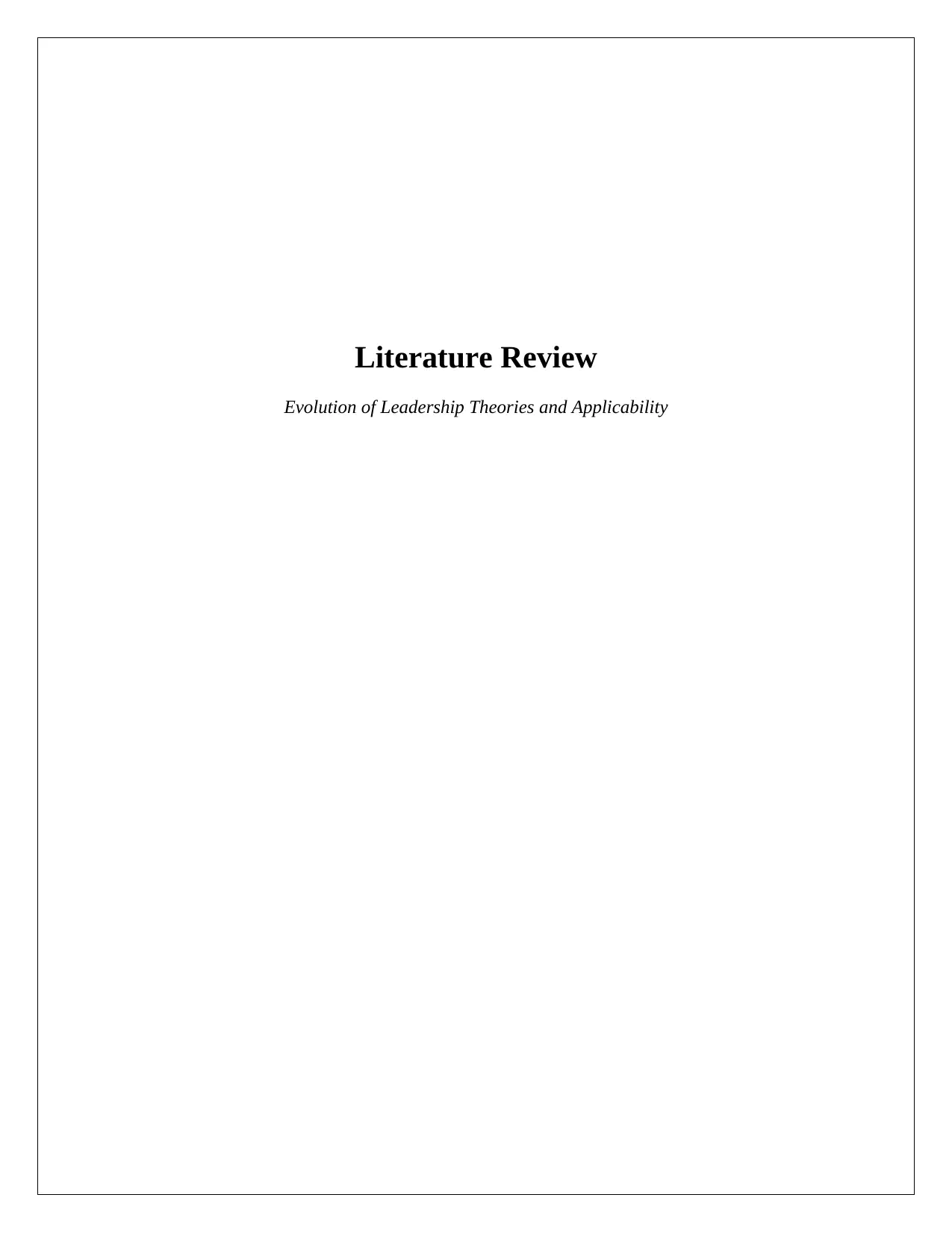
Literature Review
Evolution of Leadership Theories and Applicability
Evolution of Leadership Theories and Applicability
Paraphrase This Document
Need a fresh take? Get an instant paraphrase of this document with our AI Paraphraser
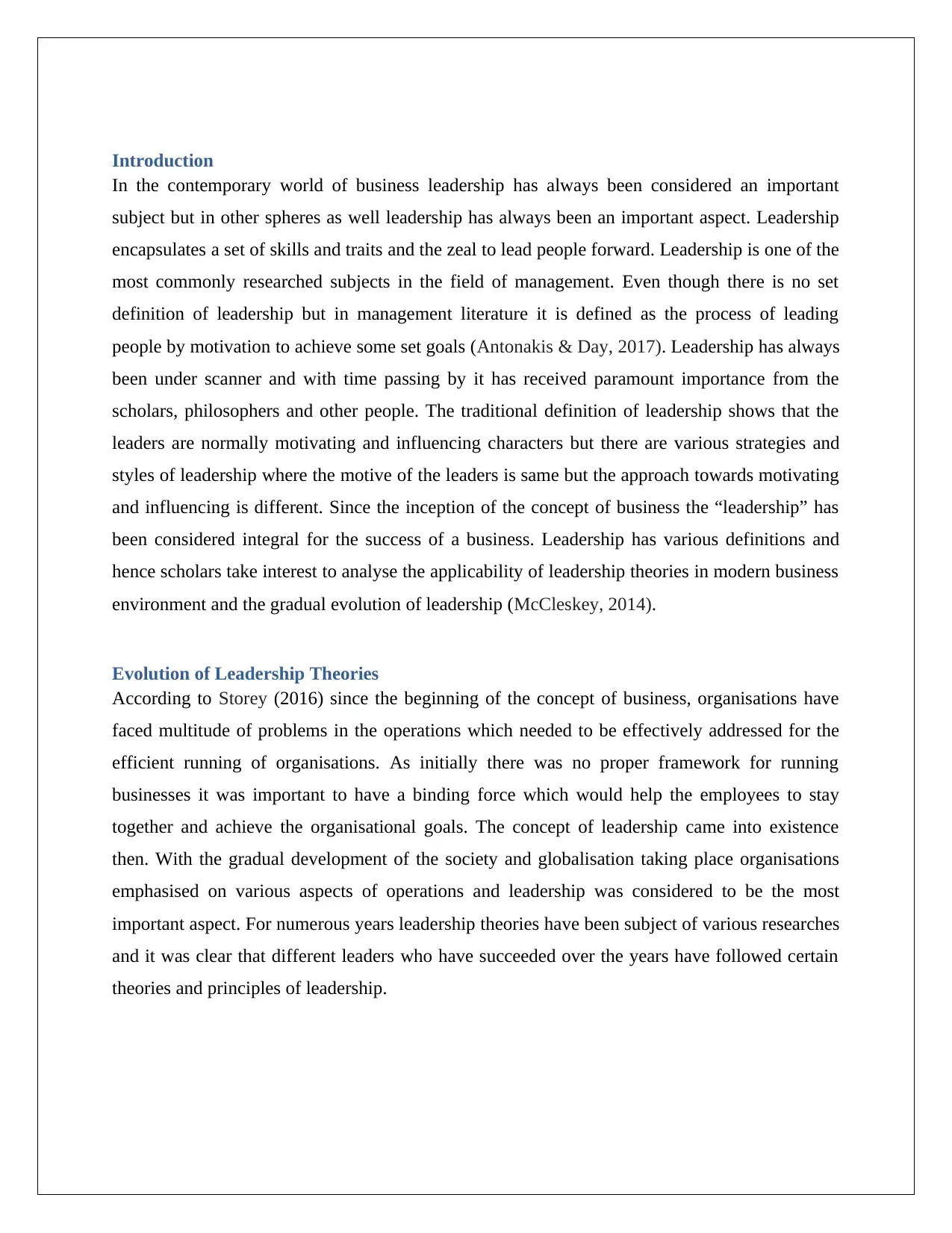
Introduction
In the contemporary world of business leadership has always been considered an important
subject but in other spheres as well leadership has always been an important aspect. Leadership
encapsulates a set of skills and traits and the zeal to lead people forward. Leadership is one of the
most commonly researched subjects in the field of management. Even though there is no set
definition of leadership but in management literature it is defined as the process of leading
people by motivation to achieve some set goals (Antonakis & Day, 2017). Leadership has always
been under scanner and with time passing by it has received paramount importance from the
scholars, philosophers and other people. The traditional definition of leadership shows that the
leaders are normally motivating and influencing characters but there are various strategies and
styles of leadership where the motive of the leaders is same but the approach towards motivating
and influencing is different. Since the inception of the concept of business the “leadership” has
been considered integral for the success of a business. Leadership has various definitions and
hence scholars take interest to analyse the applicability of leadership theories in modern business
environment and the gradual evolution of leadership (McCleskey, 2014).
Evolution of Leadership Theories
According to Storey (2016) since the beginning of the concept of business, organisations have
faced multitude of problems in the operations which needed to be effectively addressed for the
efficient running of organisations. As initially there was no proper framework for running
businesses it was important to have a binding force which would help the employees to stay
together and achieve the organisational goals. The concept of leadership came into existence
then. With the gradual development of the society and globalisation taking place organisations
emphasised on various aspects of operations and leadership was considered to be the most
important aspect. For numerous years leadership theories have been subject of various researches
and it was clear that different leaders who have succeeded over the years have followed certain
theories and principles of leadership.
In the contemporary world of business leadership has always been considered an important
subject but in other spheres as well leadership has always been an important aspect. Leadership
encapsulates a set of skills and traits and the zeal to lead people forward. Leadership is one of the
most commonly researched subjects in the field of management. Even though there is no set
definition of leadership but in management literature it is defined as the process of leading
people by motivation to achieve some set goals (Antonakis & Day, 2017). Leadership has always
been under scanner and with time passing by it has received paramount importance from the
scholars, philosophers and other people. The traditional definition of leadership shows that the
leaders are normally motivating and influencing characters but there are various strategies and
styles of leadership where the motive of the leaders is same but the approach towards motivating
and influencing is different. Since the inception of the concept of business the “leadership” has
been considered integral for the success of a business. Leadership has various definitions and
hence scholars take interest to analyse the applicability of leadership theories in modern business
environment and the gradual evolution of leadership (McCleskey, 2014).
Evolution of Leadership Theories
According to Storey (2016) since the beginning of the concept of business, organisations have
faced multitude of problems in the operations which needed to be effectively addressed for the
efficient running of organisations. As initially there was no proper framework for running
businesses it was important to have a binding force which would help the employees to stay
together and achieve the organisational goals. The concept of leadership came into existence
then. With the gradual development of the society and globalisation taking place organisations
emphasised on various aspects of operations and leadership was considered to be the most
important aspect. For numerous years leadership theories have been subject of various researches
and it was clear that different leaders who have succeeded over the years have followed certain
theories and principles of leadership.
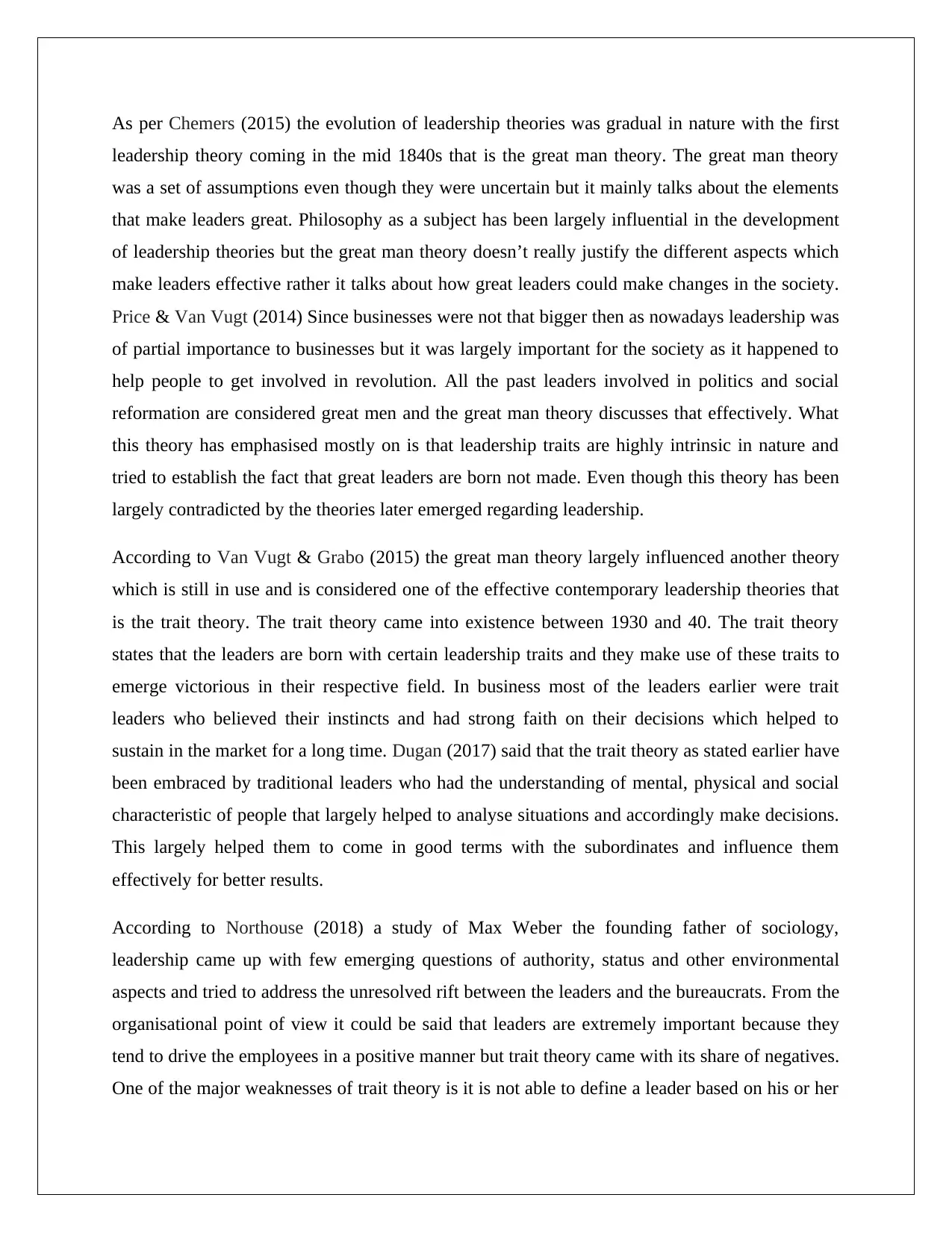
As per Chemers (2015) the evolution of leadership theories was gradual in nature with the first
leadership theory coming in the mid 1840s that is the great man theory. The great man theory
was a set of assumptions even though they were uncertain but it mainly talks about the elements
that make leaders great. Philosophy as a subject has been largely influential in the development
of leadership theories but the great man theory doesn’t really justify the different aspects which
make leaders effective rather it talks about how great leaders could make changes in the society.
Price & Van Vugt (2014) Since businesses were not that bigger then as nowadays leadership was
of partial importance to businesses but it was largely important for the society as it happened to
help people to get involved in revolution. All the past leaders involved in politics and social
reformation are considered great men and the great man theory discusses that effectively. What
this theory has emphasised mostly on is that leadership traits are highly intrinsic in nature and
tried to establish the fact that great leaders are born not made. Even though this theory has been
largely contradicted by the theories later emerged regarding leadership.
According to Van Vugt & Grabo (2015) the great man theory largely influenced another theory
which is still in use and is considered one of the effective contemporary leadership theories that
is the trait theory. The trait theory came into existence between 1930 and 40. The trait theory
states that the leaders are born with certain leadership traits and they make use of these traits to
emerge victorious in their respective field. In business most of the leaders earlier were trait
leaders who believed their instincts and had strong faith on their decisions which helped to
sustain in the market for a long time. Dugan (2017) said that the trait theory as stated earlier have
been embraced by traditional leaders who had the understanding of mental, physical and social
characteristic of people that largely helped to analyse situations and accordingly make decisions.
This largely helped them to come in good terms with the subordinates and influence them
effectively for better results.
According to Northouse (2018) a study of Max Weber the founding father of sociology,
leadership came up with few emerging questions of authority, status and other environmental
aspects and tried to address the unresolved rift between the leaders and the bureaucrats. From the
organisational point of view it could be said that leaders are extremely important because they
tend to drive the employees in a positive manner but trait theory came with its share of negatives.
One of the major weaknesses of trait theory is it is not able to define a leader based on his or her
leadership theory coming in the mid 1840s that is the great man theory. The great man theory
was a set of assumptions even though they were uncertain but it mainly talks about the elements
that make leaders great. Philosophy as a subject has been largely influential in the development
of leadership theories but the great man theory doesn’t really justify the different aspects which
make leaders effective rather it talks about how great leaders could make changes in the society.
Price & Van Vugt (2014) Since businesses were not that bigger then as nowadays leadership was
of partial importance to businesses but it was largely important for the society as it happened to
help people to get involved in revolution. All the past leaders involved in politics and social
reformation are considered great men and the great man theory discusses that effectively. What
this theory has emphasised mostly on is that leadership traits are highly intrinsic in nature and
tried to establish the fact that great leaders are born not made. Even though this theory has been
largely contradicted by the theories later emerged regarding leadership.
According to Van Vugt & Grabo (2015) the great man theory largely influenced another theory
which is still in use and is considered one of the effective contemporary leadership theories that
is the trait theory. The trait theory came into existence between 1930 and 40. The trait theory
states that the leaders are born with certain leadership traits and they make use of these traits to
emerge victorious in their respective field. In business most of the leaders earlier were trait
leaders who believed their instincts and had strong faith on their decisions which helped to
sustain in the market for a long time. Dugan (2017) said that the trait theory as stated earlier have
been embraced by traditional leaders who had the understanding of mental, physical and social
characteristic of people that largely helped to analyse situations and accordingly make decisions.
This largely helped them to come in good terms with the subordinates and influence them
effectively for better results.
According to Northouse (2018) a study of Max Weber the founding father of sociology,
leadership came up with few emerging questions of authority, status and other environmental
aspects and tried to address the unresolved rift between the leaders and the bureaucrats. From the
organisational point of view it could be said that leaders are extremely important because they
tend to drive the employees in a positive manner but trait theory came with its share of negatives.
One of the major weaknesses of trait theory is it is not able to define a leader based on his or her
⊘ This is a preview!⊘
Do you want full access?
Subscribe today to unlock all pages.

Trusted by 1+ million students worldwide
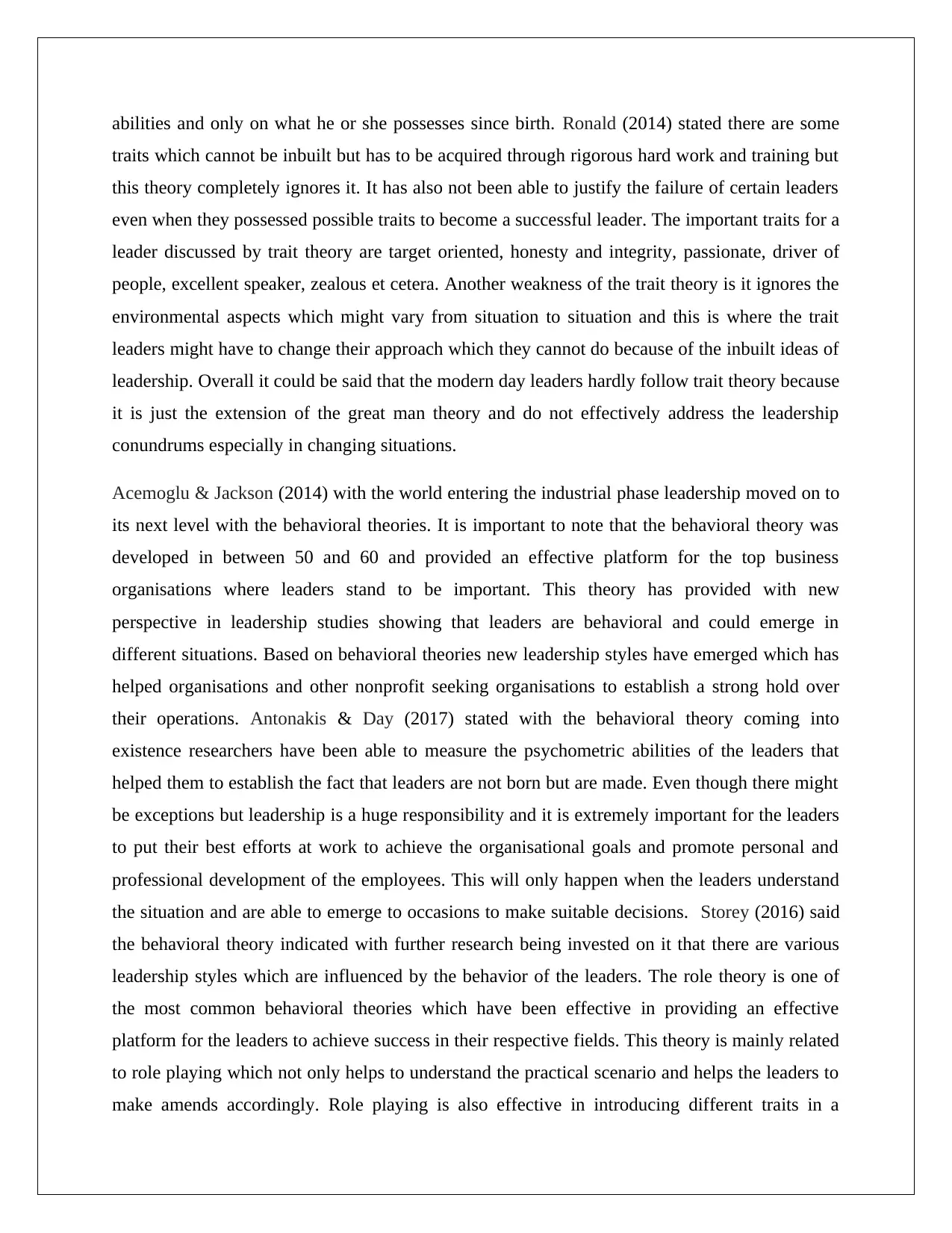
abilities and only on what he or she possesses since birth. Ronald (2014) stated there are some
traits which cannot be inbuilt but has to be acquired through rigorous hard work and training but
this theory completely ignores it. It has also not been able to justify the failure of certain leaders
even when they possessed possible traits to become a successful leader. The important traits for a
leader discussed by trait theory are target oriented, honesty and integrity, passionate, driver of
people, excellent speaker, zealous et cetera. Another weakness of the trait theory is it ignores the
environmental aspects which might vary from situation to situation and this is where the trait
leaders might have to change their approach which they cannot do because of the inbuilt ideas of
leadership. Overall it could be said that the modern day leaders hardly follow trait theory because
it is just the extension of the great man theory and do not effectively address the leadership
conundrums especially in changing situations.
Acemoglu & Jackson (2014) with the world entering the industrial phase leadership moved on to
its next level with the behavioral theories. It is important to note that the behavioral theory was
developed in between 50 and 60 and provided an effective platform for the top business
organisations where leaders stand to be important. This theory has provided with new
perspective in leadership studies showing that leaders are behavioral and could emerge in
different situations. Based on behavioral theories new leadership styles have emerged which has
helped organisations and other nonprofit seeking organisations to establish a strong hold over
their operations. Antonakis & Day (2017) stated with the behavioral theory coming into
existence researchers have been able to measure the psychometric abilities of the leaders that
helped them to establish the fact that leaders are not born but are made. Even though there might
be exceptions but leadership is a huge responsibility and it is extremely important for the leaders
to put their best efforts at work to achieve the organisational goals and promote personal and
professional development of the employees. This will only happen when the leaders understand
the situation and are able to emerge to occasions to make suitable decisions. Storey (2016) said
the behavioral theory indicated with further research being invested on it that there are various
leadership styles which are influenced by the behavior of the leaders. The role theory is one of
the most common behavioral theories which have been effective in providing an effective
platform for the leaders to achieve success in their respective fields. This theory is mainly related
to role playing which not only helps to understand the practical scenario and helps the leaders to
make amends accordingly. Role playing is also effective in introducing different traits in a
traits which cannot be inbuilt but has to be acquired through rigorous hard work and training but
this theory completely ignores it. It has also not been able to justify the failure of certain leaders
even when they possessed possible traits to become a successful leader. The important traits for a
leader discussed by trait theory are target oriented, honesty and integrity, passionate, driver of
people, excellent speaker, zealous et cetera. Another weakness of the trait theory is it ignores the
environmental aspects which might vary from situation to situation and this is where the trait
leaders might have to change their approach which they cannot do because of the inbuilt ideas of
leadership. Overall it could be said that the modern day leaders hardly follow trait theory because
it is just the extension of the great man theory and do not effectively address the leadership
conundrums especially in changing situations.
Acemoglu & Jackson (2014) with the world entering the industrial phase leadership moved on to
its next level with the behavioral theories. It is important to note that the behavioral theory was
developed in between 50 and 60 and provided an effective platform for the top business
organisations where leaders stand to be important. This theory has provided with new
perspective in leadership studies showing that leaders are behavioral and could emerge in
different situations. Based on behavioral theories new leadership styles have emerged which has
helped organisations and other nonprofit seeking organisations to establish a strong hold over
their operations. Antonakis & Day (2017) stated with the behavioral theory coming into
existence researchers have been able to measure the psychometric abilities of the leaders that
helped them to establish the fact that leaders are not born but are made. Even though there might
be exceptions but leadership is a huge responsibility and it is extremely important for the leaders
to put their best efforts at work to achieve the organisational goals and promote personal and
professional development of the employees. This will only happen when the leaders understand
the situation and are able to emerge to occasions to make suitable decisions. Storey (2016) said
the behavioral theory indicated with further research being invested on it that there are various
leadership styles which are influenced by the behavior of the leaders. The role theory is one of
the most common behavioral theories which have been effective in providing an effective
platform for the leaders to achieve success in their respective fields. This theory is mainly related
to role playing which not only helps to understand the practical scenario and helps the leaders to
make amends accordingly. Role playing is also effective in introducing different traits in a
Paraphrase This Document
Need a fresh take? Get an instant paraphrase of this document with our AI Paraphraser
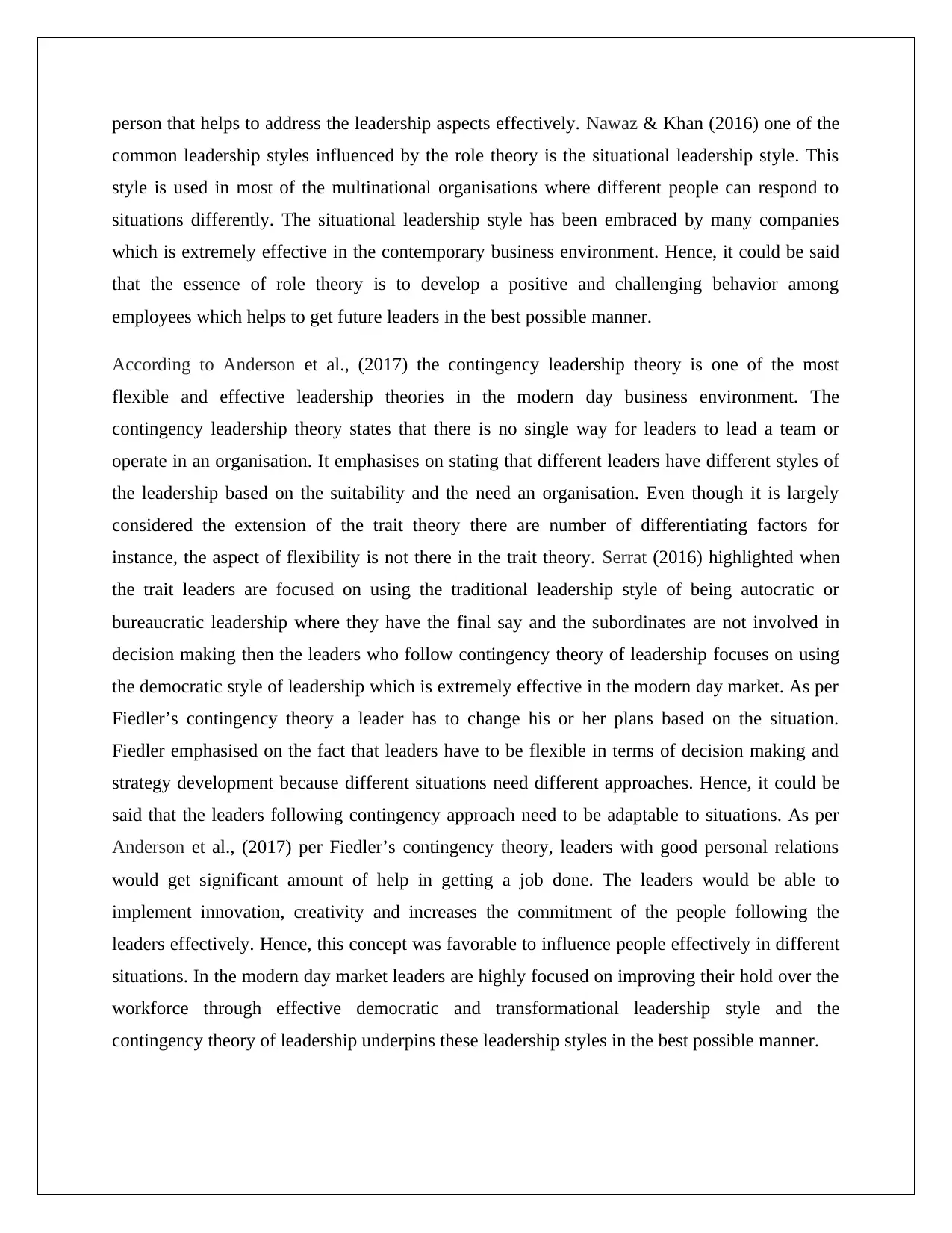
person that helps to address the leadership aspects effectively. Nawaz & Khan (2016) one of the
common leadership styles influenced by the role theory is the situational leadership style. This
style is used in most of the multinational organisations where different people can respond to
situations differently. The situational leadership style has been embraced by many companies
which is extremely effective in the contemporary business environment. Hence, it could be said
that the essence of role theory is to develop a positive and challenging behavior among
employees which helps to get future leaders in the best possible manner.
According to Anderson et al., (2017) the contingency leadership theory is one of the most
flexible and effective leadership theories in the modern day business environment. The
contingency leadership theory states that there is no single way for leaders to lead a team or
operate in an organisation. It emphasises on stating that different leaders have different styles of
the leadership based on the suitability and the need an organisation. Even though it is largely
considered the extension of the trait theory there are number of differentiating factors for
instance, the aspect of flexibility is not there in the trait theory. Serrat (2016) highlighted when
the trait leaders are focused on using the traditional leadership style of being autocratic or
bureaucratic leadership where they have the final say and the subordinates are not involved in
decision making then the leaders who follow contingency theory of leadership focuses on using
the democratic style of leadership which is extremely effective in the modern day market. As per
Fiedler’s contingency theory a leader has to change his or her plans based on the situation.
Fiedler emphasised on the fact that leaders have to be flexible in terms of decision making and
strategy development because different situations need different approaches. Hence, it could be
said that the leaders following contingency approach need to be adaptable to situations. As per
Anderson et al., (2017) per Fiedler’s contingency theory, leaders with good personal relations
would get significant amount of help in getting a job done. The leaders would be able to
implement innovation, creativity and increases the commitment of the people following the
leaders effectively. Hence, this concept was favorable to influence people effectively in different
situations. In the modern day market leaders are highly focused on improving their hold over the
workforce through effective democratic and transformational leadership style and the
contingency theory of leadership underpins these leadership styles in the best possible manner.
common leadership styles influenced by the role theory is the situational leadership style. This
style is used in most of the multinational organisations where different people can respond to
situations differently. The situational leadership style has been embraced by many companies
which is extremely effective in the contemporary business environment. Hence, it could be said
that the essence of role theory is to develop a positive and challenging behavior among
employees which helps to get future leaders in the best possible manner.
According to Anderson et al., (2017) the contingency leadership theory is one of the most
flexible and effective leadership theories in the modern day business environment. The
contingency leadership theory states that there is no single way for leaders to lead a team or
operate in an organisation. It emphasises on stating that different leaders have different styles of
the leadership based on the suitability and the need an organisation. Even though it is largely
considered the extension of the trait theory there are number of differentiating factors for
instance, the aspect of flexibility is not there in the trait theory. Serrat (2016) highlighted when
the trait leaders are focused on using the traditional leadership style of being autocratic or
bureaucratic leadership where they have the final say and the subordinates are not involved in
decision making then the leaders who follow contingency theory of leadership focuses on using
the democratic style of leadership which is extremely effective in the modern day market. As per
Fiedler’s contingency theory a leader has to change his or her plans based on the situation.
Fiedler emphasised on the fact that leaders have to be flexible in terms of decision making and
strategy development because different situations need different approaches. Hence, it could be
said that the leaders following contingency approach need to be adaptable to situations. As per
Anderson et al., (2017) per Fiedler’s contingency theory, leaders with good personal relations
would get significant amount of help in getting a job done. The leaders would be able to
implement innovation, creativity and increases the commitment of the people following the
leaders effectively. Hence, this concept was favorable to influence people effectively in different
situations. In the modern day market leaders are highly focused on improving their hold over the
workforce through effective democratic and transformational leadership style and the
contingency theory of leadership underpins these leadership styles in the best possible manner.
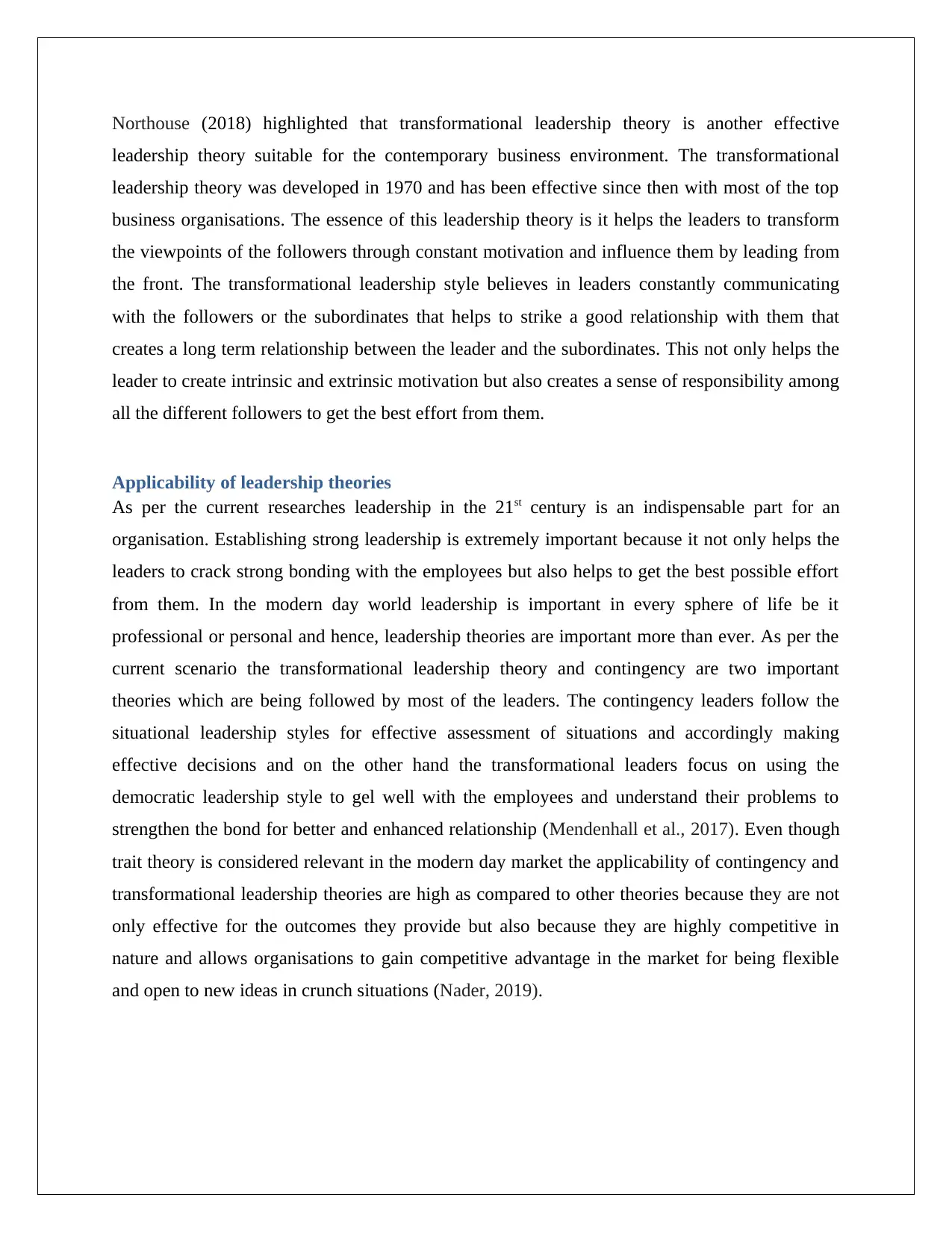
Northouse (2018) highlighted that transformational leadership theory is another effective
leadership theory suitable for the contemporary business environment. The transformational
leadership theory was developed in 1970 and has been effective since then with most of the top
business organisations. The essence of this leadership theory is it helps the leaders to transform
the viewpoints of the followers through constant motivation and influence them by leading from
the front. The transformational leadership style believes in leaders constantly communicating
with the followers or the subordinates that helps to strike a good relationship with them that
creates a long term relationship between the leader and the subordinates. This not only helps the
leader to create intrinsic and extrinsic motivation but also creates a sense of responsibility among
all the different followers to get the best effort from them.
Applicability of leadership theories
As per the current researches leadership in the 21st century is an indispensable part for an
organisation. Establishing strong leadership is extremely important because it not only helps the
leaders to crack strong bonding with the employees but also helps to get the best possible effort
from them. In the modern day world leadership is important in every sphere of life be it
professional or personal and hence, leadership theories are important more than ever. As per the
current scenario the transformational leadership theory and contingency are two important
theories which are being followed by most of the leaders. The contingency leaders follow the
situational leadership styles for effective assessment of situations and accordingly making
effective decisions and on the other hand the transformational leaders focus on using the
democratic leadership style to gel well with the employees and understand their problems to
strengthen the bond for better and enhanced relationship (Mendenhall et al., 2017). Even though
trait theory is considered relevant in the modern day market the applicability of contingency and
transformational leadership theories are high as compared to other theories because they are not
only effective for the outcomes they provide but also because they are highly competitive in
nature and allows organisations to gain competitive advantage in the market for being flexible
and open to new ideas in crunch situations (Nader, 2019).
leadership theory suitable for the contemporary business environment. The transformational
leadership theory was developed in 1970 and has been effective since then with most of the top
business organisations. The essence of this leadership theory is it helps the leaders to transform
the viewpoints of the followers through constant motivation and influence them by leading from
the front. The transformational leadership style believes in leaders constantly communicating
with the followers or the subordinates that helps to strike a good relationship with them that
creates a long term relationship between the leader and the subordinates. This not only helps the
leader to create intrinsic and extrinsic motivation but also creates a sense of responsibility among
all the different followers to get the best effort from them.
Applicability of leadership theories
As per the current researches leadership in the 21st century is an indispensable part for an
organisation. Establishing strong leadership is extremely important because it not only helps the
leaders to crack strong bonding with the employees but also helps to get the best possible effort
from them. In the modern day world leadership is important in every sphere of life be it
professional or personal and hence, leadership theories are important more than ever. As per the
current scenario the transformational leadership theory and contingency are two important
theories which are being followed by most of the leaders. The contingency leaders follow the
situational leadership styles for effective assessment of situations and accordingly making
effective decisions and on the other hand the transformational leaders focus on using the
democratic leadership style to gel well with the employees and understand their problems to
strengthen the bond for better and enhanced relationship (Mendenhall et al., 2017). Even though
trait theory is considered relevant in the modern day market the applicability of contingency and
transformational leadership theories are high as compared to other theories because they are not
only effective for the outcomes they provide but also because they are highly competitive in
nature and allows organisations to gain competitive advantage in the market for being flexible
and open to new ideas in crunch situations (Nader, 2019).
⊘ This is a preview!⊘
Do you want full access?
Subscribe today to unlock all pages.

Trusted by 1+ million students worldwide
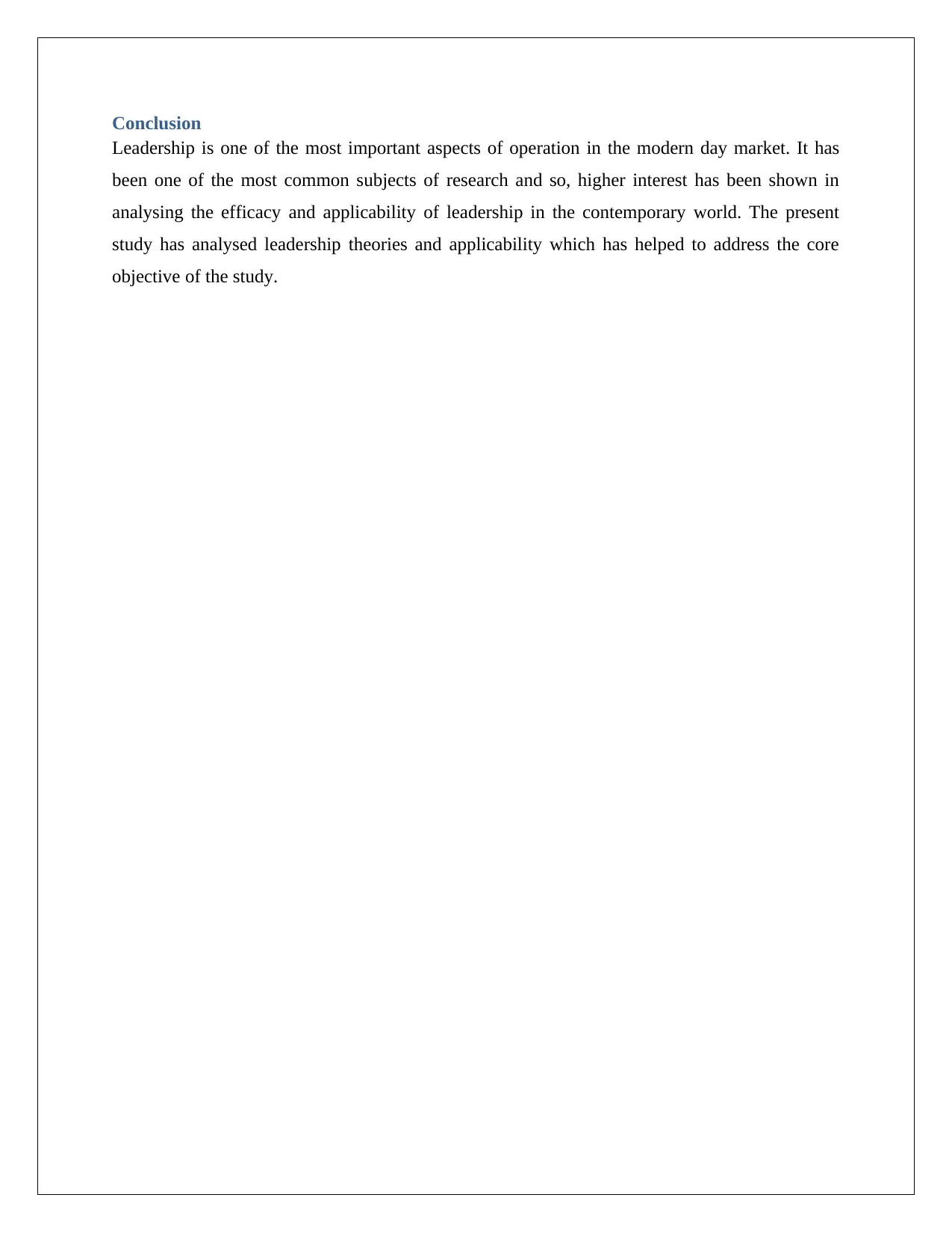
Conclusion
Leadership is one of the most important aspects of operation in the modern day market. It has
been one of the most common subjects of research and so, higher interest has been shown in
analysing the efficacy and applicability of leadership in the contemporary world. The present
study has analysed leadership theories and applicability which has helped to address the core
objective of the study.
Leadership is one of the most important aspects of operation in the modern day market. It has
been one of the most common subjects of research and so, higher interest has been shown in
analysing the efficacy and applicability of leadership in the contemporary world. The present
study has analysed leadership theories and applicability which has helped to address the core
objective of the study.
Paraphrase This Document
Need a fresh take? Get an instant paraphrase of this document with our AI Paraphraser
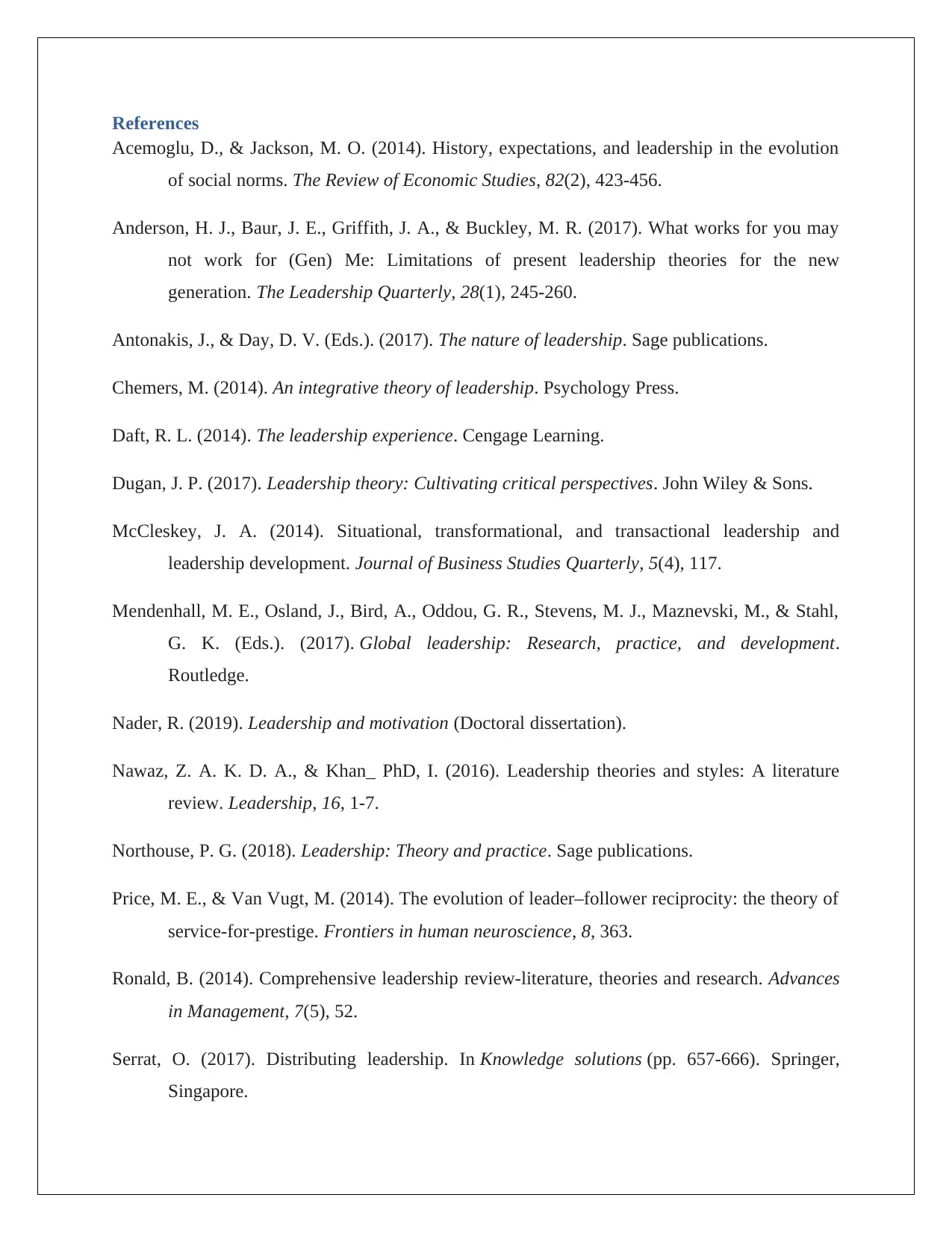
References
Acemoglu, D., & Jackson, M. O. (2014). History, expectations, and leadership in the evolution
of social norms. The Review of Economic Studies, 82(2), 423-456.
Anderson, H. J., Baur, J. E., Griffith, J. A., & Buckley, M. R. (2017). What works for you may
not work for (Gen) Me: Limitations of present leadership theories for the new
generation. The Leadership Quarterly, 28(1), 245-260.
Antonakis, J., & Day, D. V. (Eds.). (2017). The nature of leadership. Sage publications.
Chemers, M. (2014). An integrative theory of leadership. Psychology Press.
Daft, R. L. (2014). The leadership experience. Cengage Learning.
Dugan, J. P. (2017). Leadership theory: Cultivating critical perspectives. John Wiley & Sons.
McCleskey, J. A. (2014). Situational, transformational, and transactional leadership and
leadership development. Journal of Business Studies Quarterly, 5(4), 117.
Mendenhall, M. E., Osland, J., Bird, A., Oddou, G. R., Stevens, M. J., Maznevski, M., & Stahl,
G. K. (Eds.). (2017). Global leadership: Research, practice, and development.
Routledge.
Nader, R. (2019). Leadership and motivation (Doctoral dissertation).
Nawaz, Z. A. K. D. A., & Khan_ PhD, I. (2016). Leadership theories and styles: A literature
review. Leadership, 16, 1-7.
Northouse, P. G. (2018). Leadership: Theory and practice. Sage publications.
Price, M. E., & Van Vugt, M. (2014). The evolution of leader–follower reciprocity: the theory of
service-for-prestige. Frontiers in human neuroscience, 8, 363.
Ronald, B. (2014). Comprehensive leadership review-literature, theories and research. Advances
in Management, 7(5), 52.
Serrat, O. (2017). Distributing leadership. In Knowledge solutions (pp. 657-666). Springer,
Singapore.
Acemoglu, D., & Jackson, M. O. (2014). History, expectations, and leadership in the evolution
of social norms. The Review of Economic Studies, 82(2), 423-456.
Anderson, H. J., Baur, J. E., Griffith, J. A., & Buckley, M. R. (2017). What works for you may
not work for (Gen) Me: Limitations of present leadership theories for the new
generation. The Leadership Quarterly, 28(1), 245-260.
Antonakis, J., & Day, D. V. (Eds.). (2017). The nature of leadership. Sage publications.
Chemers, M. (2014). An integrative theory of leadership. Psychology Press.
Daft, R. L. (2014). The leadership experience. Cengage Learning.
Dugan, J. P. (2017). Leadership theory: Cultivating critical perspectives. John Wiley & Sons.
McCleskey, J. A. (2014). Situational, transformational, and transactional leadership and
leadership development. Journal of Business Studies Quarterly, 5(4), 117.
Mendenhall, M. E., Osland, J., Bird, A., Oddou, G. R., Stevens, M. J., Maznevski, M., & Stahl,
G. K. (Eds.). (2017). Global leadership: Research, practice, and development.
Routledge.
Nader, R. (2019). Leadership and motivation (Doctoral dissertation).
Nawaz, Z. A. K. D. A., & Khan_ PhD, I. (2016). Leadership theories and styles: A literature
review. Leadership, 16, 1-7.
Northouse, P. G. (2018). Leadership: Theory and practice. Sage publications.
Price, M. E., & Van Vugt, M. (2014). The evolution of leader–follower reciprocity: the theory of
service-for-prestige. Frontiers in human neuroscience, 8, 363.
Ronald, B. (2014). Comprehensive leadership review-literature, theories and research. Advances
in Management, 7(5), 52.
Serrat, O. (2017). Distributing leadership. In Knowledge solutions (pp. 657-666). Springer,
Singapore.
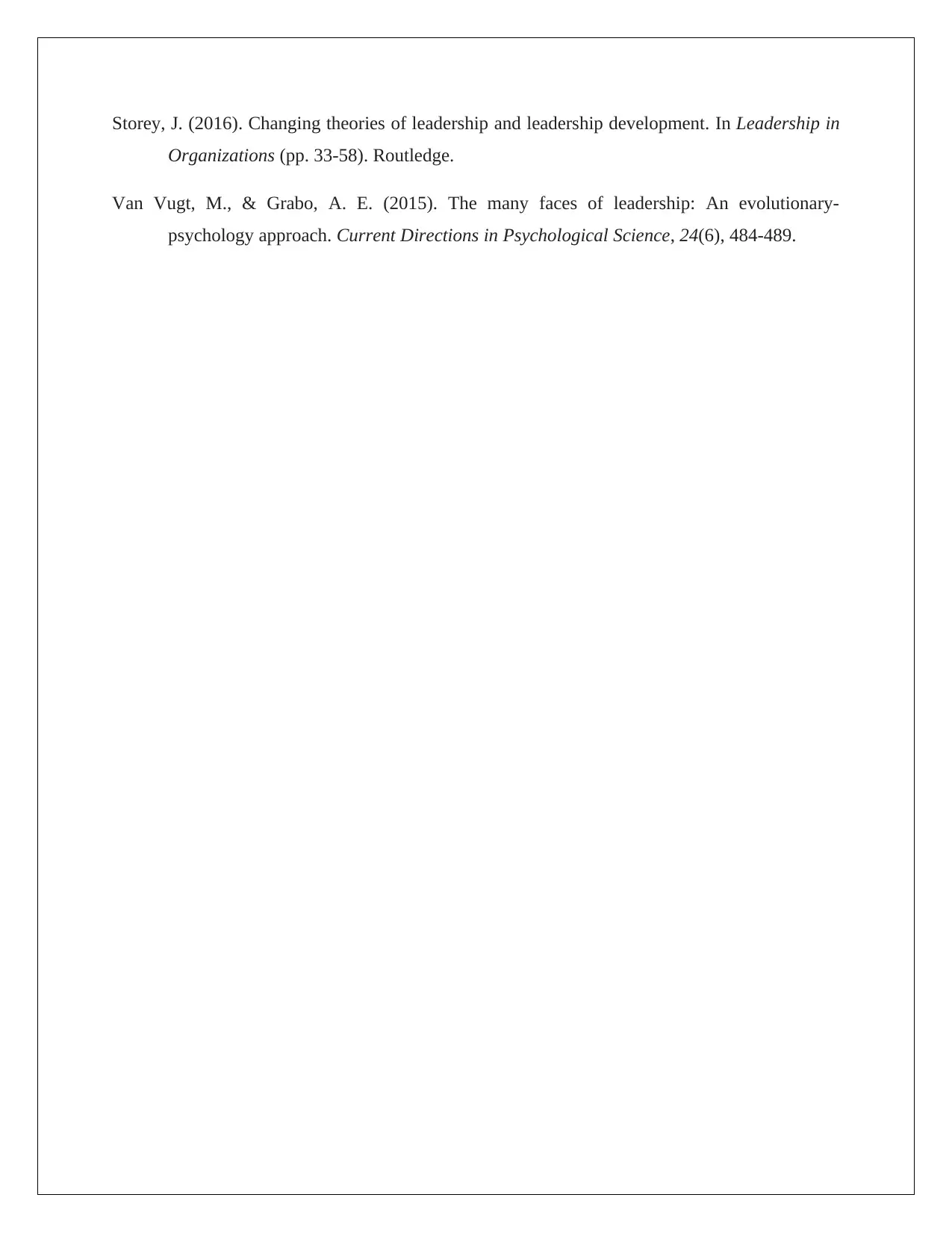
Storey, J. (2016). Changing theories of leadership and leadership development. In Leadership in
Organizations (pp. 33-58). Routledge.
Van Vugt, M., & Grabo, A. E. (2015). The many faces of leadership: An evolutionary-
psychology approach. Current Directions in Psychological Science, 24(6), 484-489.
Organizations (pp. 33-58). Routledge.
Van Vugt, M., & Grabo, A. E. (2015). The many faces of leadership: An evolutionary-
psychology approach. Current Directions in Psychological Science, 24(6), 484-489.
⊘ This is a preview!⊘
Do you want full access?
Subscribe today to unlock all pages.

Trusted by 1+ million students worldwide
1 out of 9
Related Documents
Your All-in-One AI-Powered Toolkit for Academic Success.
+13062052269
info@desklib.com
Available 24*7 on WhatsApp / Email
![[object Object]](/_next/static/media/star-bottom.7253800d.svg)
Unlock your academic potential
Copyright © 2020–2025 A2Z Services. All Rights Reserved. Developed and managed by ZUCOL.



